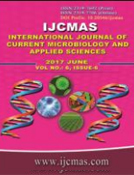


 National Academy of Agricultural Sciences (NAAS)
National Academy of Agricultural Sciences (NAAS)

|
PRINT ISSN : 2319-7692
Online ISSN : 2319-7706 Issues : 12 per year Publisher : Excellent Publishers Email : editorijcmas@gmail.com / submit@ijcmas.com Editor-in-chief: Dr.M.Prakash Index Copernicus ICV 2018: 95.39 NAAS RATING 2020: 5.38 |
This study was carried out to assess the microbiological quality of the meat of the frog, Hoplobatrachus occipitalis, which is used as an alternative source of protein (food). Samples were collected from Igwuruta, in Ikwerre Local Government Area of Rivers State, Nigeria. The research work was done to determine if there is any potential risk of food borne infection from consuming these frogs by the communities. Standard microbiological techniques were used for the analysis. Total heterotrophic bacterial counts, coliform and fungi associated with the mouth, gut and skin were analysed. The bacterial flora isolated from the samples include Escherichia coli, Salmonella typhi, Vibrio cholerae, Shigella sp., Staphylococcus aureus, Bacillus sp., Pseudomonas sp., Klebsiella sp., Proteus sp., Serratia sp., Aerobacter sp. and Enterobacter sp. The fungal groups identified were as follows: Penicillium notatum, Aspergillus niger, Aspergillus fumigates, Rhizopus sp., Mucor sp., Fusarium sp., Saccharomyces sp., Candida sp. The identification of coliforms indicates faecal contamination and likely presence of pathogens. This frog meat poses public health hazards to the people in that area who eat it. The microorganisms associated with the meat affect the quality and safety of the meat for human consumption. Improper cooking of the meat and handling could result in outbreak of food borne diseases such as cholera and dysentery, leading to great economic losses of money and man hours. Greatest effect will be observed in children, the elderly and also in the immunocompromised patients.
 |
 |
 |
 |
 |